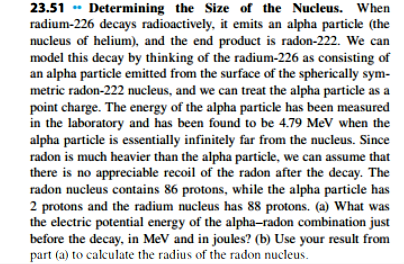23.51 Determining the Size of the Nucleus. When radium-226 decays radioactively, it emits an alpha particle (the nucleus of helium), and the end product is radon-222. We can model this decay by thinking of the radium-226 as consisting of an alpha particle emitted from the surface of the spherically sym metric radon-222 nucleus, and we can treat the alpha particle as a point charge. The energy of the alpha particle has been measured in the laboratory and has been found to be 4.79 MeV when the alpha particle is essentially infinitely far from the nucleus. Since radon is much heavier than the alpha particle, we can assume that there is no appreciable recoil of the radon after the decay. The radon nucleus contains 86 protons, while the alpha particle has 2 protons and the radium nucleus has 88 protons. (a) What was the electric potential energy of the alpha-radon combination just before the decay, in MeV and in joules? (b) Use your result part (a) to calculate the radius of the radon nucleus
23.51 Determining the Size of the Nucleus. When radium-226 decays radioactively, it emits an alpha particle (the nucleus of helium), and the end product is radon-222. We can model this decay by thinking of the radium-226 as consisting of an alpha particle emitted from the surface of the spherically sym metric radon-222 nucleus, and we can treat the alpha particle as a point charge. The energy of the alpha particle has been measured in the laboratory and has been found to be 4.79 MeV when the alpha particle is essentially infinitely far from the nucleus. Since radon is much heavier than the alpha particle, we can assume that there is no appreciable recoil of the radon after the decay. The radon nucleus contains 86 protons, while the alpha particle has 2 protons and the radium nucleus has 88 protons. (a) What was the electric potential energy of the alpha-radon combination just before the decay, in MeV and in joules? (b) Use your result part (a) to calculate the radius of the radon nucleus
Physics for Scientists and Engineers: Foundations and Connections
1st Edition
ISBN:9781133939146
Author:Katz, Debora M.
Publisher:Katz, Debora M.
Chapter24: Electric Fields
Section: Chapter Questions
Problem 54PQ: A uniformly charged ring of radius R = 25.0 cm carrying a total charge of 15.0 C is placed at the...
Related questions
Question
Question in pic below.

Transcribed Image Text:23.51 Determining the Size of the Nucleus. When
radium-226 decays radioactively, it emits an alpha particle (the
nucleus of helium), and the end product is radon-222. We can
model this decay by thinking of the radium-226 as consisting of
an alpha particle emitted from the surface of the spherically sym
metric radon-222 nucleus, and we can treat the alpha particle as a
point charge. The energy of the alpha particle has been measured
in the laboratory and has been found to be 4.79 MeV when the
alpha particle is essentially infinitely far from the nucleus. Since
radon is much heavier than the alpha particle, we can assume that
there is no appreciable recoil of the radon after the decay. The
radon nucleus contains 86 protons, while the alpha particle has
2 protons and the radium nucleus has 88 protons. (a) What was
the electric potential energy of the alpha-radon combination just
before the decay, in MeV and in joules? (b) Use your result
part (a) to calculate the radius of the radon nucleus
Expert Solution
This question has been solved!
Explore an expertly crafted, step-by-step solution for a thorough understanding of key concepts.
This is a popular solution!
Trending now
This is a popular solution!
Step by step
Solved in 2 steps with 2 images

Knowledge Booster
Learn more about
Need a deep-dive on the concept behind this application? Look no further. Learn more about this topic, physics and related others by exploring similar questions and additional content below.Recommended textbooks for you

Physics for Scientists and Engineers: Foundations…
Physics
ISBN:
9781133939146
Author:
Katz, Debora M.
Publisher:
Cengage Learning

Physics for Scientists and Engineers, Technology …
Physics
ISBN:
9781305116399
Author:
Raymond A. Serway, John W. Jewett
Publisher:
Cengage Learning

Principles of Physics: A Calculus-Based Text
Physics
ISBN:
9781133104261
Author:
Raymond A. Serway, John W. Jewett
Publisher:
Cengage Learning

Physics for Scientists and Engineers: Foundations…
Physics
ISBN:
9781133939146
Author:
Katz, Debora M.
Publisher:
Cengage Learning

Physics for Scientists and Engineers, Technology …
Physics
ISBN:
9781305116399
Author:
Raymond A. Serway, John W. Jewett
Publisher:
Cengage Learning

Principles of Physics: A Calculus-Based Text
Physics
ISBN:
9781133104261
Author:
Raymond A. Serway, John W. Jewett
Publisher:
Cengage Learning